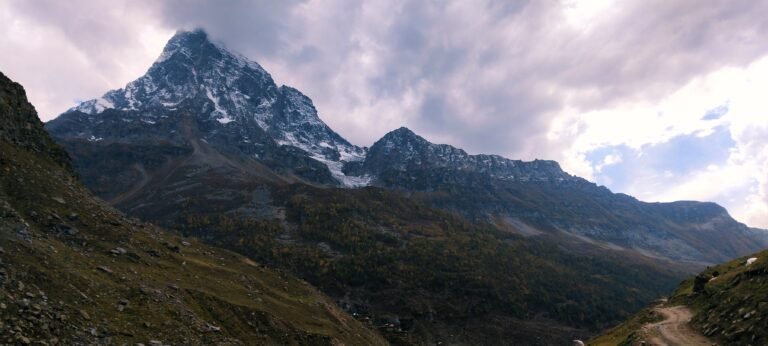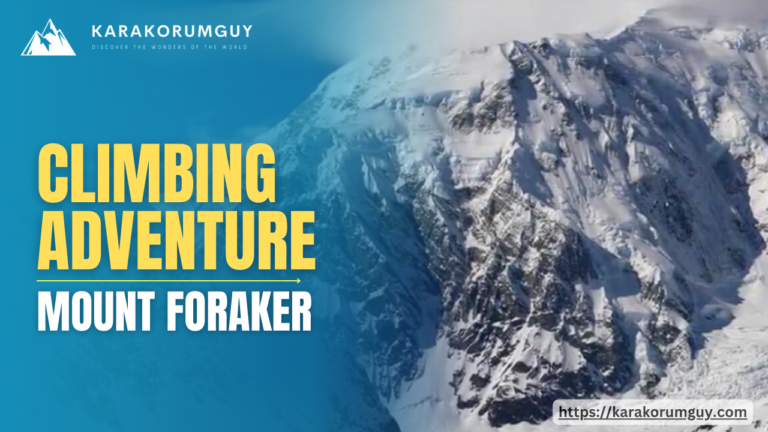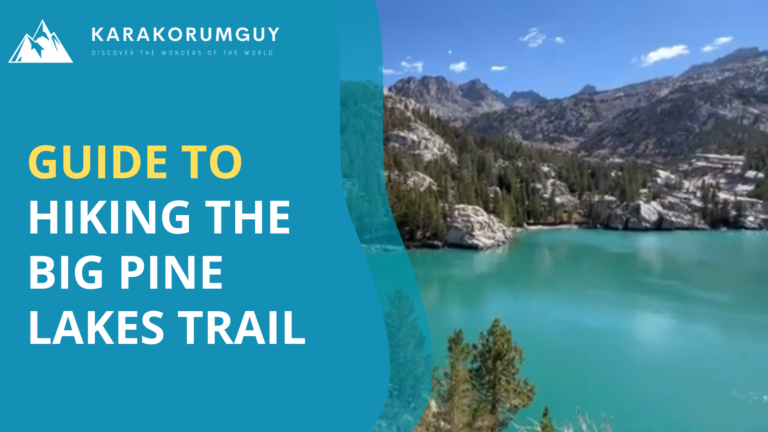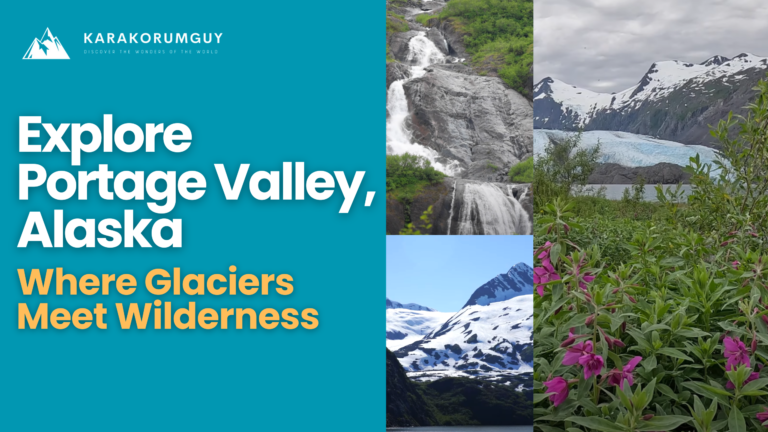Makalu: 5th Highest Mountain in the World

Mount Makalu, the fifth highest peak in the world, stands tall and proud in the mighty Himalayas. Its soaring heights, rugged terrain, and breathtaking vistas make it a dream destination for mountaineers and adventurers worldwide.
So, If you’re on the hunt for adventurous peaks to explore in Nepal, you’re in luck! This blog is just what you need. In this article, we’re going to take a close look at Makalu, the world’s 5th highest mountain peak. Let’s dive deep into all the fascinating details about this incredible peak.
Geographical Location of Makalu
It is situated in the Himalayas, straddling the border between Nepal and China (Tibet). Its precise coordinates are approximately 27.8899° N latitude and 87.0889° E longitude.
Height of Makalu
It stands as the fifth highest mountain globally, with an impressive elevation of 8,485 meters (27,838 feet) above sea level.
Peaks of the Makalu Massif
Makalu, a prominent mountain in the Himalayas, is surrounded by several notable peaks that contribute to its stunning landscape. Here are its main peaks:
1. Makalu Main:
The highest peak in the Makalu massif, standing tall at an elevation of 8,485 meters (27,838 feet) above sea level. It is the primary objective for climbers aiming to summit Makalu.
2. Kangchungtse:
Also known as Makalu II, Kangchungtse is the second highest peak in the Makalu massif. It reaches an elevation of 7,678 meters (25,190 feet) and offers breathtaking views of the surrounding Himalayan peaks.
3. Chomo Lonzo:
Chomo Lonzo, or Makalu III, is the third highest peak in the Makalu massif. It stands at an elevation of 7,804 meters (25,600 feet) and adds to the rugged beauty of the region.
4. Makalu IV:
This peak, also referred to as Makalu West, is situated to the west of Makalu Main. It has an elevation of 7,727 meters (25,354 feet) and contributes to the majestic skyline of the Makalu massif.
5. Kangchung West:
Located to the southwest of Makalu Main, Kangchung West is a subsidiary peak with an elevation of 7,680 meters (25,200 feet). It enhances the scenic beauty of the Makalu region.
These peaks, along with other smaller summits and ridges, form the awe-inspiring panorama of the Makalu massif, attracting climbers and nature enthusiasts from across the globe.

Is Mount Makalu considered dangerous?
Climbing this mountain is undoubtedly a dangerous endeavor, with a notable fatality rate reflecting the challenges and risks involved. However, for seasoned mountaineers seeking the ultimate test of skill and endurance, summiting Makalu represents a formidable achievement worth pursuing with caution, respect for the mountain, and a deep understanding of the risks involved. Below are the factors contributing to the danger:
Factors Contributing to the Danger:
- Technical Difficulty: Its routes involve challenging technical climbs, including steep ice and rock faces, crevasses, and seracs. Negotiating these obstacles requires advanced climbing skills and experience.
- High Altitude: Makalu’s extreme altitude means climbers are susceptible to altitude-related illnesses such as acute mountain sickness, high-altitude pulmonary edema (HAPE), and high-altitude cerebral edema (HACE). These conditions can be life-threatening if not properly managed.
- Weather: The weather on Makalu can be notoriously unpredictable, with sudden storms, high winds, and extreme cold posing significant hazards to climbers. Rapid changes in weather conditions can leave climbers exposed and vulnerable.
- Avalanche Risk: Makalu’s steep slopes increase the risk of avalanches, especially during periods of heavy snowfall or rapid temperature changes. Avalanches pose a significant threat to climbers on both the ascent and descent.
- Remote Location: Situated in a remote region of the Himalayas, Makalu’s isolation complicates rescue efforts in the event of emergencies. Limited access to medical facilities and communication channels further exacerbates the challenges faced by climbers in need of assistance.
Despite these dangers, Mount Makalu continues to attract adventurous climbers seeking to conquer its formidable slopes. However, those embarking on this perilous ascent must do so with meticulous planning, extensive preparation, and a profound respect for the mountain’s unforgiving nature.
Fatality Rate of Makalu: Exploring the Risks
It is standing at 8,485 meters (27,838 feet), presents formidable challenges to climbers. While exact fatality rates can vary from year to year and are influenced by a multitude of factors, including weather conditions, individual climber experience, and the route chosen, Makalu is generally considered one of the more dangerous peaks to summit.
The statistics also shows the danger of Makalu, with a fatality rate of approximately 14 deaths per 100 successful summits. The fatality rate is relatively high compared to some other peaks in the eight-thousander. This is due in part to its technical difficulty, unpredictable weather patterns, and the inherent risks associated with high-altitude mountaineering.
Makalu: A Legacy of Climbing Triumphs
Makalu has a rich climbing history and has witnessed several notable ascents over the years.
- First Ascent: The first successful ascent of Makalu was made on May 15, 1955, by a French team led by Jean Franco. Lionel Terray and Jean Couzy were the climbers who reached the summit.
- Noble Ascents: Since its first ascent, Makalu has been climbed by various expeditions and climbers, with many notable ascents:
- Japanese climber in 1970, Yutaka Ageta made the first solo ascent of Makalu.
- Slovenian team in 1971, led by Tone Škarja made the first ascent of the Southwest Pillar, a difficult and technical route.
- French climber Marc Batard in 1980, made a remarkable speed ascent of Makalu, reaching the summit in just 22 hours from Base Camp, setting a new record at the time.
- In 2009, Spanish climber Edurne Pasaban became the first woman to climb all fourteen eight-thousanders, including Makalu.
- In 2010, Polish climber Kinga Baranowska summited Makalu without using supplementary oxygen, adding to her impressive list of high-altitude achievements.
These ascents, among others, showcase the diverse challenges and achievements associated with climbing Makalu, highlighting the mountain’s allure to adventurers from around the world.

Unveiling the Best Climbing Routes
It offers several climbing routes, each presenting its own challenges and highlights. Here are the main climbing routes on Mount Makalu, along with their overview, highlights, and difficulty levels:
1. West Ridge Route:
- Overview: The West Ridge Route on Mount Makalu starts from the West Col, which is accessed from the Makalu Base Camp. It involves technical climbing with steep sections and mixed terrain.
- Highlights: This route offers stunning views of the surrounding Himalayan peaks, including Everest, Lhotse, and Kangchenjunga.
- Difficulty Level: Considered to be one of the most challenging routes on Makalu due to its technical nature and exposure to high-altitude conditions.
2. North Ridge Route:
- Overview: The North Ridge Route begins from the Makalu Base Camp and follows the northern ridge of the mountain. It involves steep snow and ice climbing, with some technical sections.
- Highlights: Climbers on this route are rewarded with breathtaking views of the Tibetan Plateau to the north and the surrounding Himalayan peaks.
- Difficulty Level: This route is also considered challenging, requiring technical climbing skills and experience in high-altitude environments.
3. Southeast Ridge Route (Normal Route):
- Overview: The Southeast Ridge Route, also known as the Normal Route, is the most commonly used route to summit Makalu. It begins from the Makalu Base Camp and ascends via the southeast ridge, traversing glaciers and snow slopes.
- Highlights: Despite being the standard route, it still offers spectacular views of the Everest region and the neighboring peaks.
- Difficulty Level: While technically less challenging compared to the West Ridge and North Ridge routes, it still requires mountaineering experience and proper acclimatization.
4. South Face Route:
- Overview: The South Face Route is a less frequented and more technical route on Mount Makalu. It involves climbing the steep southern face of the mountain, which includes rock, ice, and mixed terrain.
- Highlights: Climbers on this route experience the solitude of a less-traveled path and encounter varied climbing challenges.
- Difficulty Level: Considered to be one of the most technically demanding routes on Makalu, requiring advanced climbing skills and experience in alpine environments.
These routes offer a variety of challenges and experiences for mountaineers seeking to summit Mount Makalu. It’s essential for climbers to assess their skills, experience, and resources carefully before attempting any route on this formidable peak.
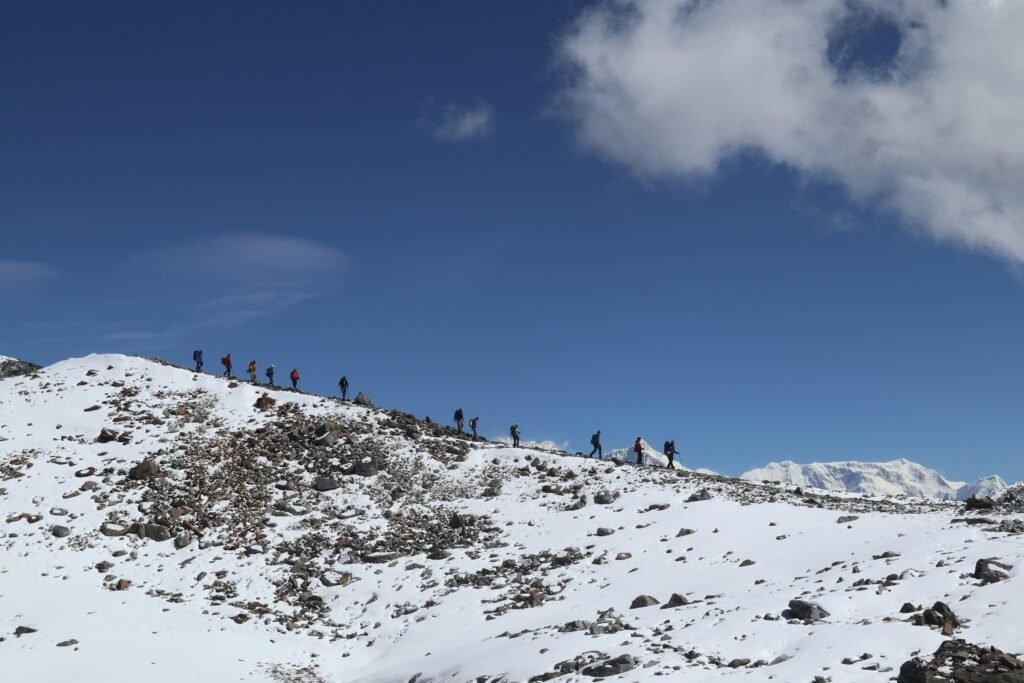
Factors to Consider Before Climbing
Before embarking on a climbing expedition, several factors should be carefully considered to ensure safety and success:
1. Physical Fitness:
Climbing at high altitudes demands excellent physical conditioning. Endurance, strength, and cardiovascular fitness are crucial for tackling challenging terrain and coping with reduced oxygen levels.
2. Technical Skills:
Proficiency in relevant technical skills such as rope handling, rock climbing, ice climbing, and glacier travel is essential. Climbers should be comfortable using specialized equipment and techniques required for the specific route.
3. Altitude Acclimatization:
Adequate time for acclimatization is vital to minimize the risk of altitude-related illnesses such as acute mountain sickness, high altitude pulmonary edema (HAPE), and high altitude cerebral edema (HACE). Gradual ascent and rest days at intermediate altitudes help the body adjust to reduced oxygen levels.
4. Weather Conditions:
Weather in mountainous regions can be unpredictable and severe. Climbers should closely monitor weather forecasts and plan their ascent during favorable conditions to minimize exposure to hazards such as storms, high winds, and extreme cold.
5. Route Selection:
Choosing an appropriate route based on skill level, experience, and objective is crucial. Factors such as route difficulty, technical challenges, avalanche risk, and objective hazards should be carefully evaluated before proceeding.
6. Team Dynamics:
Effective communication, teamwork, and mutual support are essential for a successful climb. Climbers should establish clear roles and responsibilities, maintain situational awareness, and prioritize safety above all else.
7. Emergency Preparedness:
Adequate preparation for emergencies is essential. Climbers should carry essential medical supplies, communication devices, and emergency shelter. Familiarity with first aid techniques and evacuation procedures is critical in case of accidents or adverse health conditions.
8. Environmental Considerations:
Respect for the natural environment is paramount. Climbers should adhere to Leave No Trace principles, minimize their impact on fragile ecosystems, and respect local customs and regulations.
9. Experience and Training:
Climbing challenging peaks requires prior experience and training. Novice climbers should gain experience on less demanding routes and gradually build their skills and confidence before attempting more difficult objectives.
10. Risk Management:
Assessing and mitigating risks is essential for safe climbing. Climbers should continually evaluate hazards, make informed decisions, and be prepared to retreat if conditions become unsafe.
By carefully considering these factors and taking appropriate precautions, climbers can increase their chances of a safe and successful ascent while minimizing risks and adverse outcomes.
Trekking in Makalu
Trekking in the Makalu region began in the late 20th century, with early expeditions paving the way for established routes. Over the years, the region has gained popularity among trekkers for its challenging terrain and unspoiled wilderness.
Choosing the Right Trekking Route
When planning a trek in this region, it’s essential to consider factors such as duration, difficulty level, and personal preferences. Several routes cater to varying skill levels and interests, ensuring there’s something for everyone.

Makalu Trekking Routes
1. Makalu Base Camp Trek
- Overview: This trek offers a remarkable journey to the base camp of Mount Makalu, the fifth highest peak in the world.
- Route Description: Starting from Tumlingtar, the trail passes through lush forests, remote villages, and high alpine landscapes before reaching the base camp.
- Highlights: Stunning views of Mount Makalu, diverse flora and fauna, crossing high mountain passes like Shipton La.
2. Makalu Circuit Trek
- Overview: The Makalu Circuit Trek combines the beauty of the Makalu Base Camp route with a traverse through the remote Barun Valley.
- Route Description: Starting from Tumlingtar, the trail follows the Arun River before entering the Barun Valley and then ascending to Makalu Base Camp. The return journey often takes a different route via Sherpani Col and Amphu Laptsa Pass.
- Highlights: Varied landscapes, pristine wilderness, encounters with local ethnic groups like Sherpas and Rai people.
3. Makalu to Everest Trek
- Overview: This challenging trek connects the Makalu region with the Everest region, offering a unique adventure through two of Nepal’s iconic peaks.
- Route Description: Starting from Tumlingtar, the trail heads towards Makalu Base Camp before crossing Sherpani Col and West Col to reach the Everest region. It then follows the classic Everest Base Camp route to Lukla.
- Highlights: Spectacular views of Makalu and Everest, crossing high mountain passes, experiencing the cultural diversity of both regions.
4. Makalu Sherpani Col Trek
- Overview: A challenging trek that includes crossing the technical Sherpani Col pass, offering adventurous trekkers a thrilling experience.
- Route Description: Starting from Tumlingtar, the trail leads to Makalu Base Camp before ascending towards Sherpani Col and crossing into the Everest region via the Amphu Laptsa Pass.
- Highlights: Adventure of crossing high mountain passes, breathtaking views of Makalu and Everest, exploration of remote and untouched landscapes.
5. Arun Valley Trek
- Overview: An alternative trekking route that explores the lush Arun Valley, offering a less crowded but equally rewarding experience.
- Route Description: Starting from Tumlingtar, the trail follows the Arun River valley, passing through traditional villages, terraced fields, and dense forests.
- Highlights: Rich cultural experiences, encounters with diverse flora and fauna, panoramic views of the Himalayan peaks surrounding the valley.
Best Time to Visit for Trekking and Climbing
The best time to visit Makalu for trekking and climbing is during the spring (March to May) and autumn (September to November) seasons. During these times, the weather is generally stable, with clear skies and moderate temperatures, making it ideal for outdoor activities. Spring brings blooming rhododendrons and lush vegetation, while autumn offers stunning views of the surrounding peaks with clear visibility. However, it’s essential to check weather forecasts and be prepared for sudden changes in weather conditions, especially at higher altitudes.
Why to choose Makalu for trekking and climbing?
There are several compelling reasons to choose this mountain for trekking and climbing:
1. Remote and Pristine Beauty:
It is located in a remote region of the Himalayas, offering pristine natural beauty and solitude away from the crowds often found on more popular peaks like Everest. The unspoiled landscapes, diverse ecosystems, and stunning mountain vistas make it a paradise for nature enthusiasts and adventure seekers.
2. Challenging Terrain:
Makalu presents a formidable challenge for climbers and trekkers, with steep slopes, crevasses, and technical terrain that require skill, endurance, and determination to navigate. For those seeking a true test of their mountaineering abilities, it provides an exhilarating and rewarding experience.
3. Cultural Immersion:
Trekking in the Makalu region offers the opportunity to immerse oneself in the rich cultural heritage of the local Sherpa and Rai communities. Visitors can explore traditional villages, monasteries, and religious sites, gaining insight into the unique way of life and customs of the Himalayan people.
4. Less Crowded:
Compared to more popular trekking routes like the Everest Base Camp or Annapurna Circuit, Makalu sees far fewer visitors, allowing for a more authentic and tranquil trekking experience. The solitude and serenity of the wilderness enhance the sense of adventure and connection with nature.
5. Varied Landscapes:
Its region boasts diverse landscapes, ranging from lush forests and alpine meadows to rugged glaciers and towering peaks. Trekking through such varied terrain offers constantly changing scenery and opportunities for exploration and discovery.
6. Summit Challenge:
Climbing Makalu is a significant mountaineering achievement, with its challenging ascent to the summit standing at 8,485 meters (27,838 feet) above sea level. For experienced climbers looking to push their limits and conquer one of the world’s highest peaks, it presents an enticing challenge.
7. Adventure of a Lifetime:
Whether trekking through remote valleys, crossing high mountain passes, or scaling snowy peaks, exploring Makalu offers the adventure of a lifetime. The sense of accomplishment and awe-inspiring beauty of the Himalayas leave a lasting impression on all who venture into this majestic wilderness.
Essential Gear List for Trekking and Climbing Makalu
here’s an essential gear list for trekking and climbing Makalu:
- Clothing:
- Base layers (moisture-wicking)
- Insulating layers (fleece or down jacket)
- Waterproof and windproof jacket and pants
- Trekking pants and shorts
- Thermal underwear
- Gloves (insulated and waterproof)
- Warm hat and sun hat
- Hiking socks (wool or synthetic)
- Gaiters (for snow and mud protection)
- Footwear:
- Sturdy hiking boots with ankle support
- Approach shoes or sandals for camp
- Equipment:
- Backpack (40-70 liters)
- Trekking poles
- Sleeping bag (rated for cold temperatures)
- Sleeping pad (insulated)
- Tent (4-season or expedition tent)
- Headlamp with extra batteries
- Sunglasses (UV protection)
- Sunscreen and lip balm with SPF
- Personal first aid kit
- Water bottles or hydration system
- Trekking map and compass or GPS device
- Multi-tool or knife
- Whistle
- Trekking permit and necessary documents
- Climbing Gear (for technical sections):
- Mountaineering boots
- Crampons
- Ice axe
- Climbing harness
- Helmet
- Carabiners and locking carabiners
- Climbing rope
- Ascender/descender device
- Prusik cords
- Food and Nutrition:
- High-energy snacks (nuts, energy bars, chocolate)
- Dehydrated meals or freeze-dried food
- Electrolyte tablets
- Water purification system or water purification tablets
- Miscellaneous:
- Camera or smartphone for capturing memories
- Portable charger or solar charger
- Lightweight, quick-dry towel
- Toilet paper and hand sanitizer
- Trash bags for waste disposal
- Book or journal for downtime
Remember to adjust the gear list based on your specific needs, the duration of your trek, and the weather conditions you anticipate encountering on Makalu. It’s also crucial to ensure all technical climbing gear is in good condition and that you’re proficient in using it before attempting any climbs.
Safety Tips for Climbing and Trekking Mount Makalu
When embarking on climbing and trekking expeditions to Makalu, one of the highest peaks in the world, safety should always be a top priority. Here are some important safety tips to keep in mind:
- Ensure you are physically fit and adequately trained before attempting the climb or trek.
- Acclimatize properly to the altitude to prevent altitude sickness.
- Carry sufficient food, water, and supplies for the duration of your trek or climb.
- Dress in layers to accommodate changing weather conditions; include waterproof and windproof clothing.
- Use proper climbing equipment, including harnesses, ropes, and helmets, and ensure they are in good condition.
- Stay on marked trails to avoid getting lost or encountering dangerous terrain.
- Be aware of weather forecasts and avoid climbing in poor weather conditions.
- Stay hydrated and eat regularly to maintain energy levels.
- Take regular breaks to rest and avoid overexertion.
- Communicate your itinerary with someone reliable and check in regularly.
- Respect local customs and wildlife, and leave no trace of your presence.
- Be prepared for emergencies with a first aid kit, emergency shelter, and communication devices.
Accommodation Options in Makalu
Accommodation options directly on the Makalu trek route are limited due to its remote location. However, this offers a more authentic and adventurous experience for trekkers. Here’s what you can expect:
1. Teahouses and Lodges:
These are the most common options along the Makalu Base Camp trek route. They provide dormitory-style rooms with basic amenities such as shared bathrooms and limited electricity. The lodges offer local meals and provide an opportunity to interact with fellow trekkers.
2. Camping:
For a more immersive experience in nature, camping is another option. Designated campsites are available within Makalu Barun National Park. Trekkers can either bring their own tent or rent one from local porters.
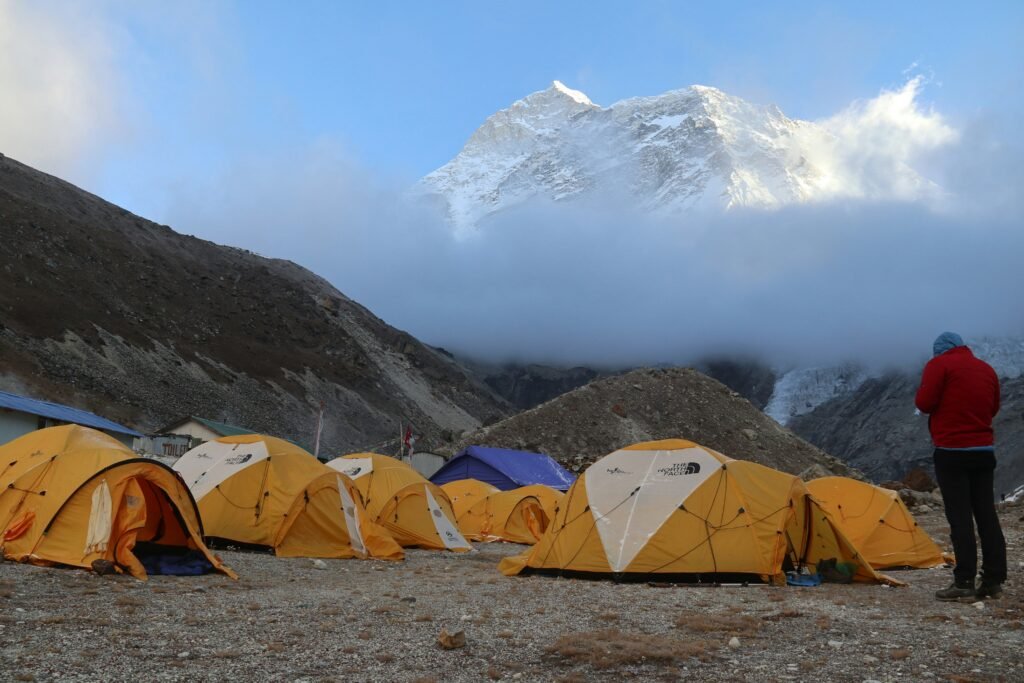
Things to Consider:
1. Booking in Advance:
Despite fewer trekkers than other regions, it’s advisable to book accommodation, especially during peak seasons (September-November and March-May).
2. Basic Amenities:
Facilities are basic, so be prepared for shared accommodations, limited electricity, and possibly no hot showers.
Getting to Makalu: Transportation Guide
Makalu is located in the Himalayas on the border between Nepal and Tibet. Accessing this remote region requires careful planning and consideration of transportation options.
1. Transportation to Kathmandu
- By Air:
- Most international travelers arrive in Nepal via Tribhuvan International Airport in Kathmandu.
- Several major airlines offer direct flights to Kathmandu from various cities around the world.
- By Land:
- Overland travel is possible from neighboring countries like India and Tibet, but it involves long bus or car journeys and border crossings.
2. Travel from Kathmandu to Tumlingtar
- By Air:
- The most convenient way to reach Tumlingtar, the nearest major town to Makalu, is by domestic flight from Kathmandu.
- Several airlines operate daily flights to Tumlingtar, with the journey taking approximately 45 minutes to 1 hour.
- By Road:
- Alternatively, travelers can opt for a bus or private vehicle from Kathmandu to Tumlingtar, but this entails a lengthy and arduous journey lasting around 2 days.
3. Tumlingtar to Chichila (Starting Point of Makalu Trek)
- By Road:
- From Tumlingtar, hire a local jeep or bus to reach Chichila, the starting point of the Makalu Base Camp trek.
- The road journey may take around 6 to 8 hours, depending on weather conditions and road quality.
4. Trekking to Makalu Base Camp
- On Foot:
- The trek from Chichila to Makalu Base Camp typically takes around 14 to 16 days.
- Trekking routes pass through remote villages, lush forests, and high-altitude landscapes, offering stunning views of the Himalayas along the way.
Things to Consider
1. Altitude Sickness Precautions:
- Makalu Base Camp sits at a high altitude, so it’s essential to acclimatize properly during the trek to avoid altitude sickness.
- Drink plenty of water, ascend slowly, and be aware of symptoms such as headache, nausea, and dizziness.
2. Physical Fitness:
- The trek to Makalu Base Camp is physically demanding and involves long days of hiking over varied terrain.
- Prior physical fitness training and preparation can greatly enhance the trekking experience.
3. Weather Conditions:
- Weather in the Himalayas can be unpredictable, with conditions changing rapidly.
- Pack appropriate clothing and gear for both warm and cold weather, and be prepared for rain, snow, and strong winds.
4. Permits and Documentation:
- Obtain the necessary permits and documentation before embarking on the trek.
- This may include a trekking permit from the Nepal Tourism Board and, if entering from Tibet, permits for border areas.
5. Travel Insurance:
- Ensure you have comprehensive travel insurance that covers trekking at high altitudes and includes emergency evacuation coverage.
- Check that your insurance policy specifically covers trekking in the Himalayas.
6. Local Customs and Culture:
- Respect local customs, traditions, and cultural practices while trekking in the region.
- Dress modestly and seek permission before taking photographs of local people or religious sites.
7. Environmental Considerations:
- Practice Leave No Trace principles to minimize your impact on the environment.
- Carry out all trash and dispose of it properly at designated waste collection points.
8. Safety Precautions:
- Trek with a reputable guide or trekking agency who is familiar with the area and can provide support in case of emergencies.
- Stay on marked trails and avoid venturing into unknown or dangerous areas.
9. Health and Medical Supplies:
- Carry a basic first aid kit with essential medical supplies, including altitude sickness medication, pain relievers, and blister treatment.
- Consult a healthcare professional before the trek to discuss any specific medical concerns or requirements.
10. Communication and Connectivity:
- Expect limited or no mobile phone reception in remote areas along the trekking route.
- Consider carrying a satellite phone or personal locator beacon for emergency communication if needed.
Conclusion
In conclusion, Mount Makalu stands as a beacon of adventure and exploration in the heart of the Himalayas, enticing climbers and trekkers with its breathtaking beauty and formidable challenges. From its remote and pristine landscapes to its rich cultural heritage, Makalu offers a journey that tests the limits of human endurance while rewarding adventurers with unforgettable experiences and stunning vistas.
However, the dangers inherent in scaling its heights serve as a reminder of the need for careful planning, respect for nature, and adherence to safety protocols. Yet, for those who heed the call of adventure, Mount Makalu promises an unparalleled expedition—a test of courage, skill, and determination that leaves an enduring mark on the soul.
Hope you found this article helpful! If you want to discover more then check our other blogs on World’s Top 10 Mountain Peaks.


